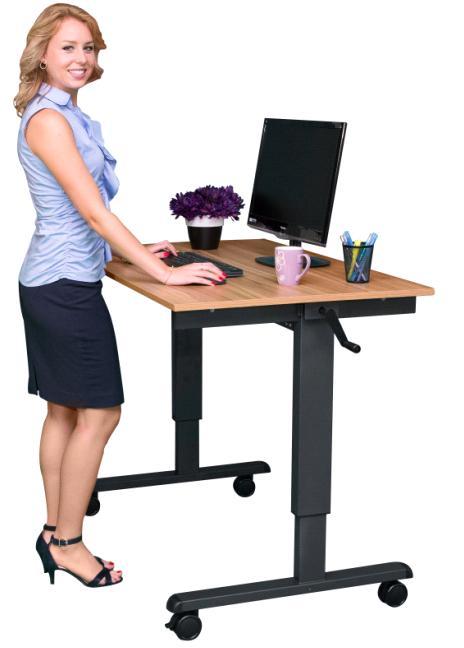 Office furniture was staid and boring for decades. Except for the big boss in the corner office, everyone else had a metal desk and a small upholstered chair that rolled on four casters on a plastic mat.
Office furniture was staid and boring for decades. Except for the big boss in the corner office, everyone else had a metal desk and a small upholstered chair that rolled on four casters on a plastic mat.
Then came cubicles a/k/a “cubes”, the workstations that became the bane of many office worker’s existence because they could hear the conversations of co-workers yet all they could see were high metal enclosures.
The office furniture manufacturers have incessantly tweaked their products to accommodate employee’s various needs. Office chairs and desks were designed to be aesthetically pleasing, but ergonomically correct. In some workplaces a whole-office ergonomic analysis was done on individual employee work stations to ensure that employees were working comfortably and without restrictions.
A few solutions
You might recall when the kneeling chair was introduced in 1979. It was a strange-looking device wherein one leaned inward and allowed the body’s weight to bear on the knees; it was meant to reduce lower back strain by dividing the burden of one’s weight between the knees and the buttocks. It seemed that this new mode of sitting provided relief to those suffering with coccyx or tailbone pain, resulting from significant numbers of hours in a sitting position from office desk jobs. The kneeling chair creates the open body angle by lowering the angle of the lower body, keeping the spine in alignment and the sitter properly positioned.
A saddle chair was another innovation that was created to emulate the riding or saddle position of a horseback rider. It worked well at keeping the body from falling forward and took the weight off the buttocks and onto the knees.
However, it is not proven that kneeling chairs or saddle chairs are an optimal solution to chronic back pain.
The standing desk
Standing desks are a good option for people with chronic back pain. Participants who used a standing desk at their workstation reduced upper back and neck pain by 54 percent. Plus, it improved their overall mood. No wonder it has been around for such a long time – although no individual can be named as the inventor of the standing desk, Leonardo da Vinci is perhaps its earliest known user.
Sitting is not healthy
The reason standing desks are gaining in popularity now is that they can help reduce chronic back pain, such as neck and back problems originating from cumulative stresses such as sitting with bad posture all day. According to a physical therapist, the spine is naturally shaped like an “S” but prolonged periods of slouching cause it to turn to a “C” with the head and neck protruding forward and the shoulders and lower back hunched. This malady is common for those individuals, predominantly office workers, who spend extended amounts of time at a desk or in front of a computer.
Sitting all the time does not just affect the spine; it can be seriously bad for your health because:
- There is an increased risk of diabetes, heart disease and/or early death; and
- Studies have linked sitting to weight gain and obesity because sitting all the time burns few calories.
This is a major problem for office workers, because they sit down for most of the day.
Standing desks are becoming increasingly more popular these days. While health experts and persons who conduct ergonomic analyses in the workplace suggest that workers should frequently change their posture throughout the course of the day, this is difficult to remember to do, and, eventually a slumping posture becomes the most-comfortable and natural position for most workers.
When you sit in a chair with poor posture the chair will still hold you up. But, you are placing stress on your spine and the supporting soft tissues which may lead to injury over time. When you’re standing you may still slouch but you have limited options and there is less stress placed on your spine.” Thus, individuals who suffer from back issues may find the solution to their spinal woes by discovering the perfect height standing desk.

Are you sold on a stand-up desk?
Though it might seem like an awkward stance, a stand-up desk allows you to stand up comfortably while working. There are modern versions of the stand-up desk which are adjustable, allowing you to easily change the height of the desk and alternate between sitting and standing. This version of the stand-up desk is usually referred to as height-adjustable desks, or sit-stand desks.
A spine surgeon in New Jersey will tell you that the stand-up desk will spell relief for chronic back problems, and that is certainly the biggest takeaway from this desk that bucks the trend of classic office furniture. We’ve discussed the benefits for back health, but it also has pretty impressive benefits for health in general by at least partly negating the harmful effects of too much sitting, not to mention the fact that you will increase your productivity.
Standing for an afternoon has been shown to burn 170 more calories than an equal amount of sitting. Over time, this difference can have a major effect on your weight. The stand-up desk is a win-win situation for you and your chronic back pain.



